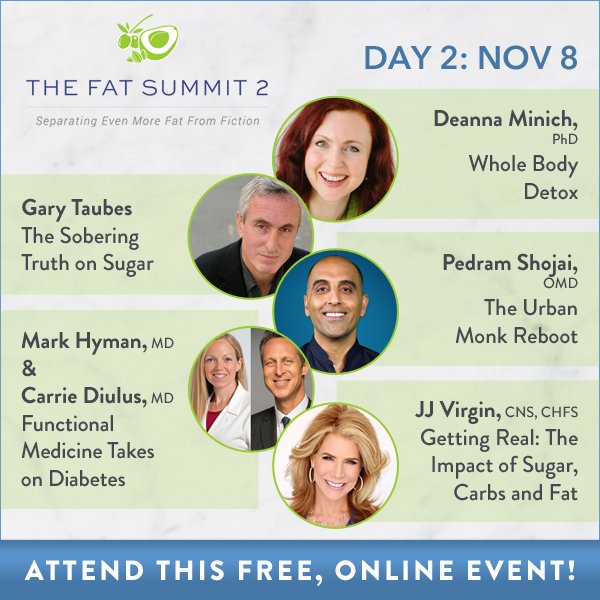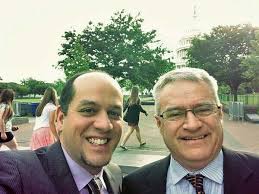
Two weeks ago I watched the Fat Summit 2 hosted by Dr. Mark Hyman. While the online conference is over, perhaps if you register you will get notified of future conferences.
I have a true thirst, or perhaps I should say, appetite, for learning how food works in our body. What causes weight gain and loss. Neither of these things is what you expect. The actual break down and metabolism of how our body uses nutrients and stores food may surprise you.
Hyman and his co-host, Carrie Diulus, an orthopedic M.D. who has type 1 diabetes, interviewed about 30 M.D.s, researchers, scientists and functional doctors to stop the demonization of fat and shed light on the fact that it’s simple carbs and sugar that play a larger role in causing damage and disease.
Nutrition journalist, Gary Taubes, author of Why We Get Fat and Good Calories, Bad Calories, and numerous articles, has researched this field for years. Early next year his new book, ‘The Case Against Sugar,’ will be published. It’s a look at our food industry historically, politically and economically.
In a nutshell, Taubes says metabolically we gain weight from too much insulin circulating in our blood stream. (Most people with type 2 diabetes who are on insulin can affirm this. If you eat the American diet with lots of carb, you raise your blood sugar. So your body pumps out more insulin or you have to inject lots of insulin. Voila, the pounds roll on.) Insulin causes weight gain. If you remember nothing after reading this complex process I’ve tried to reconstruct from Taubes’ explanation, you can just recall what fellow nutrition journalist, Nina Teicholz, said during the conference, “That bacon you eat isn’t going to turn into fat on your body, but that bagel will!”
How Fat Calories & How Sugar Calories Work in the Body (Gary Taubes)
Because we call certain foods we eat “fats” everyone assumes they’re going to make us fat. It’s the idea that you are what you eat. But the better explanation is – you are what your body does with what you eat. When we consume fat we absorb it into the blood stream. Our body then carries it to our fat tissue. It does get stored in our cells as fat – temporarily. This is what keeps confusing people: because the fat we eat is stored in our cells as fat you assume the more fat you eat the fatter you’re going to get.
The fact is, however, that the fat stored in our cells is regulated by the hormone insulin. When insulin goes up our body moves the fat from our bloodstream into our cells and stores it. When insulin goes down we take the fat out of our cells and burn it for fuel. Our insulin level is determined by the amount of carbohydrate we eat. High glycemic index carbs and sugar are going to drive up our insulin. Fat, however, is the one macronutrient (out of carbs, protein and fat) that has no effect on insulin.
If you’re going to design a diet that would minimize your fat accumulation (lower your weight), based purely on our biology and physiology, you would minimize your carbohydrate content and maximize your fat content. Protein would be a moderate amount, about 15-20% of your daily calories. Yet this diet we’re told by the researchers, even the American Heart Association, will give you heart disease. But biologically, this is how it works. And haven’t we watched America grow only fatter over the last three decades?
The opposite is also true. If you designed a diet that would make you fatter, you would eat a lot of high Glycemic Index carbs (simple carbs) and drink a lot of sugary beverages. This drives up your blood sugar which drives up your insulin. Insulin deposits the carbs you don’t burn as fuel into the cells where it gets stored as fat. Insulin tells the cells to burn carbs and store the rest as fat. Insulin gives that same signal to your organs as well. So, eat a lot of carbs and you won’t burn fat. Eat few carbs and you will. It’s your body’s go-to for fuel. Also, when your blood sugar drops after a high carb meal you get hungry. You eat again and the cycle repeats. However, a meal higher in healthy fat satiates your appetite. You don’t feel the need to eat again as your blood sugar doesn’t do a spike up and drop down.
Taubes also acknowledged this knowledge has been in medical text books forever – Elevated blood sugar stimulates insulin secretion which stimulates fat storage in our fat cells and carbohydrate storage in the liver and inhibits mobilization of fat from the fat cells.
I’ve said and written this many times – a few years ago I went on a low-carb/higher healthy fat diet. I began eating more nuts, seeds, olives, olive oil, avocados, coconut oil, some cheese and meat. I ate less carbs, hardly any simple carbs. I lost 8 pounds in a few months without trying.
Eating this way every day now keeps my weight down. I would never go back to the old way we think we should eat to lose weight – low fat, high carb. It doesn’t work, it’s unhealthy, it keeps you hungry and counting calories all day. Been there, done that for decades.
I’m thankful every day this information reached me and I trusted it enough to try it out. Your taste buds will change and in short time you won’t miss the garbage you eat now. In fact, it will taste pretty crappy. If you’re trying to lose weight and have only done it the conventional way, give low carb/healthy fat eating a try. And, watch your blood sugars flatten out and if you’re Type 2 very likely your medicines decrease.















































































